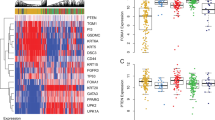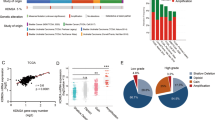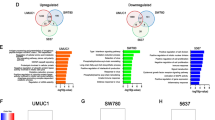Abstract
XIAP-associated factor 1 (XAF1) is a new candidate tumor suppressor, which has been known to exert proapoptotic effects by interfering with the caspase-inhibiting activity of XIAP. To explore the XAF1's candidacy for a suppressor in urogenital tumorigenesis, we investigated the XAF1 status in a series of cancer cell lines and primary tumors derived from the bladder, kidney and prostate. Expression of XAF1 transcript was undetectable or extremely low in 60% (3/5) of bladder, 66% (10/15) of kidney, and 100% (3/3) prostate cancer cell lines. Abnormal reduction of XAF1 was also found in 33% (18/55) of primary bladder and 40% (8/20) of primary kidney tumors, and showed a correlation with advanced stage and high grade of bladder tumor. Hypermethylation at 14 CpG sites in the 5′ proximal region of the XAF1 promoter was highly prevalent in cancers versus adjacent normal or benign tissues and tightly associated with reduced gene expression. XAF1 expression enhanced the apoptotic response of tumor cells to chemotherapeutic agents, such as etoposide or 5-FU. While XAF1 expression did not influence the subcellular distribution or expression of XIAP, it elevated the protein stability of p53 and its target gene expression. Moreover, the apoptosis-sensitizing and growth suppression function of XAF1 was markedly impeded by blockade of p53 function. Collectively, our study demonstrates that epigenetic alteration of XAF1 is frequent in human urogenital cancers and may contribute to the malignant progression of tumors by rendering tumor cells a survival advantage partially through the attenuated p53 response to apoptotic stresses.
This is a preview of subscription content, access via your institution
Access options
Subscribe to this journal
Receive 50 print issues and online access
$259.00 per year
only $5.18 per issue
Buy this article
- Purchase on Springer Link
- Instant access to full article PDF
Prices may be subject to local taxes which are calculated during checkout







Similar content being viewed by others
References
Ambrosini G, Adida C, Altieri DC . (1997). A novel anti-apoptosis gene, survivin, expressed in cancer and lymphoma. Nature Med 3: 917–921.
Asselin E, Mills GB, Tsang BK . (2001). XIAP regulates Akt activity and caspase-3-dependent cleavage during cisplatin-induced apoptosis in human ovarian epithelial cancer cells. Cancer Res 61: 1862–1868.
Benedict WF, Tao Z, Kim CS, Zhang X, Zhou JH, Adam L et al. (2004). Intravesical Ad-IFNα causes marked regression of human bladder cancer growing orthotopically in nude mice and overcomes resistance to IFN-α protein. Mol Ther 10: 525–532.
Bilim V, Kasahara T, Hara N, Takahashi K, Tomita Y . (2003). Role of XIAP in the malignant phenotype of transitional cell cancer (TCC) and therapeutic activity of XIAP antisense oligonucleotides against multidrug-resistant TCC in vitro. Int J Cancer 103: 29–37.
Byun DS, Cho K, Ryu BK, Lee MG, Kang MJ, Kim HR et al. (2003). Hypermethylation of XIAP-associated factor 1, a putative tumor suppressor gene from the 17p13.2 locus, in human gastric adenocarcinomas. Cancer Res 63: 7068–7075.
Chi SG, Chang SG, Lee SJ, Lee CH, Kim JI, Park JH . (1999). Elevated and biallelic expression of p73 is associated with progression of human bladder cancer. Cancer Res 59: 2791–2793.
Chi SG, deVere White RW, Meyers FJ, Siders D, Lee F, Gumerlock PH . (1994). p53 in prostate: frequent expressed transition mutations. J Natl Cancer Inst 86: 926–933.
Chi SG, Kim HJ, Park BJ, Min HJ, Park JH, Kim YW et al. (1998). Mutational abrogation of the PTEN/MMAC1 gene in gastrointestinal polyps in patients with Cowden disease. Gastroenterology 115: 1084–1089.
Deveraux QL, Reed JC . (1999). IAP family proteins-suppressors of apoptosis. Genes Dev 13: 239–252.
Deveraux QL, Takahashi R, Salvesen GS, Reed JC . (1997). X-linked IAP is a direct inhibitor of cell-death proteases. Nature 388: 300–304.
Du C, Fang M, Li Y, Li L, Wang X . (2000). Smac, a mitochondrial protein that promotes cytochrome c-dependent caspase activation by eliminating IAP inhibition. Cell 102: 33–42.
Duckett CS, Nava VE, Gedrich RW, Clem RJ, Van Dongen JL, Gilfillan MC et al. (1996). A conserved family of cellular genes related to the baculovirus iap gene and encoding apoptosis inhibitors. EMBO J 15: 2685–2689.
Fong WG, Liston P, Rajcan-Separovic E, St Jean M, Craig C, Korneluk RG . (2000). Expression and genetic analysis of XIAP-associated factor 1 (XAF1) in cancer cell lines. Genomics 70: 113–122.
Green DR . (2000). Apoptotic pathways: paper wraps stone blunts scissors. Cell 102: 1–4.
Holcik M, Gibson H, Korneluk RG . (2001). Apoptotic brake and promising therapeutic target. Apoptosis 6: 253–261.
Jackson AM, Alexandroff AB, Kelly RW, Skibinska A, Esuvaranathan K, Prescott S et al. (1995). Changes in urinary cytokines and soluble intercellular adhesion molecule-1 (ICAM-1) in bladder cancer patients after bacillus Calmette-Guerin (BCG) immunotherapy. Clin Exp Immunol 99: 369–375.
Leaman DW, Chawla-Sarkar M, Vyas K, Reheman M, Tamai K, Toji S et al. (2002). Identification of X-linked inhibitor of apoptosis-associated factor-1 as an interferon-stimulated gene that augments TRAIL Apo2L-induced apoptosis. J Biol Chem 277: 28504–28511.
Lee MG, Kim HY, Byun DS, Lee SJ, Lee CH, Kim JI et al. (2001). Frequent epigenetic inactivation of RASSF1A in human bladder carcinoma. Cancer Res 61: 6688–6692.
Li J, Kim JM, Liston P, Li M, Miyazaki T, Mackenzie AE et al. (1998). Expression of inhibitor of apoptosis proteins (IAPs) in rat granulosa cells during ovarian follicular development and atresia. Endocrinology 139: 1321–1328.
Liston P, Fong WG, Kelly NL, Toji S, Miyazaki T, Conte D et al. (2001). Identification of XAF1 as an antagonist of XIAP anti-Caspase activity. Nat Cell Biol 3: 128–133.
Liston P, Roy N, Tamai K, Lefebvre C, Baird S, Cherton-Horvat G et al. (1996). Suppression of apoptosis in mammalian cells by NAIP and a related family of IAP genes. Nature 379: 349–353.
Ludwig AT, Moore JM, Luo Y, Chen X, Saltsgaver NA, O’Donnell MA et al. (2004). Tumor necrosis factor-related apoptosis-inducing ligand: a novel mechanism for Bacillus Calmette-Guerin-induced antitumor activity. Cancer Res 64: 3386–3390.
Luo Y, Chen X, Downs TM, DeWolf WC, O’Donnell MA . (1999). IFN-α2B enhances Th1 cytokine responses in bladder cancer patients receiving Mycobacterium bovis bacillus Calmette-Guerin immunotherapy. J Immunol 162: 2399–2405.
Ng KCP, Campos EI, Martinka M, Li G . (2004). XAF1 expression is significantly reduced in human melanoma. J Invest Dermatol 123: 1127–1134.
Papageorgiou A, Lashinger L, Millikan R, Grossman HB, Benedict W, Dinney CP et al. (2004). Role of tumor necrosis factor-related apoptosis-inducing ligand in interferon-induced apoptosis in human bladder cancer cells. Cancer Res 64: 8973–8979.
Perrelet D, Perrin FE, Liston P, Korneluk RG, MacKenzie A, Ferrer-Alcon M et al. (2004). Motoneuron resistance to apoptotic cell death in vivo correlates with the ratio between X-linked inhibitor of apoptosis proteins (XIAPs) and its inhibitor, XIAP-associated factor 1. J Neurosci 24: 3777–3785.
Roy N, Deveraux QL, Takahashi R, Salvesen GS, Reed JC . (1997). The c-IAP-1 and c-IAP-2 proteins are direct inhibitors of specific caspases. EMBO J 16: 6914–6925.
Ryan KM, Vousden KH . (1998). Characterization of structural p53 mutants which show selective defects in apoptosis but not cell cycle arrest. Mol Cell Biol 18: 3692–3698.
Sasaki H, Sheng Y, Kotsuji F, Tsang BK . (2000). Down-regulation of X-linked inhibitor of apoptosis protein induces apoptosis in chemoresistant human ovarian cancer cells. Cancer Res 60: 5659–5666.
Siegelin M, Touzani O, Toutain J, Liston P, Rami A . (2005). Induction and redistribution of XAF1, a new antagonist of XIAP in the rat brain after transient focal ischemia. Neurobiol Dis 20: 509–518.
Steidl C, Simon R, Burger H, Brinkschmidt C, Hertle L, Bocker W et al. (2002). Patterns of chromosomal aberrations in urinary bladder tumours and adjacent urothelium. J Pathol 198: 115–120.
Sun C, Cai M, Gunasekera AH, Meadows RP, Wang H, Chen J et al. (1999). NMR structure and mutagenesis of the inhibitor-of-apoptosis protein XIAP. Nature 401: 818–822.
Suzuki Y, Imai Y, Nakayama H, Takahashi K, Takio K, Takahashi R . (2001). A serine protease, HtrA2, is released from the mitochondria and interacts with XIAP, inducing cell death. Mol Cell 8: 613–621.
Tamm I, Kornblau SM, Segall H, Krajewski S, Welsh K, Kitada S et al. (2001). Expression and prognostic significance of IAP-family genes in human cancers and myeloid leukemias. Clin Cancer Res 6: 1796–1803.
Thompson CB . (1995). Apoptosis in the pathogenesis and treatment of disease. Science 267: 1456–1462.
Tricoli JV, Gumerlock PH, Yao JL, Chi SG, D’Souza SA, Nestok BR et al. (1996). Alterations of the retinoblastoma gene in human prostate adenocarcinoma. Genes Chromosomes & Cancer 15: 108–114.
Verhagen AM, Ekert PG, Pakusch M, Silke J, Connolly LM, Reid GE et al. (2000). Identification of DIABLO, a mammalian protein that promotes apoptosis by binding to and antagonizing IAP proteins. Cell 102: 43–53.
Acknowledgements
This work was supported in part by grants from Korea Science and Engineering Foundation (R02-2003-000-10031-0), Korea Research Foundation (2003-070-C00031), and the National Cancer Center (0420230), Korea.
Author information
Authors and Affiliations
Corresponding author
Additional information
Supplementary Information accompanies the paper on the Oncogene website (http://www.nature.com/onc).
Supplementary information
Rights and permissions
About this article
Cite this article
Lee, MG., Huh, JS., Chung, SK. et al. Promoter CpG hypermethylation and downregulation of XAF1 expression in human urogenital malignancies: implication for attenuated p53 response to apoptotic stresses. Oncogene 25, 5807–5822 (2006). https://doi.org/10.1038/sj.onc.1209867
Received:
Revised:
Accepted:
Published:
Issue Date:
DOI: https://doi.org/10.1038/sj.onc.1209867
Keywords
This article is cited by
-
The regulation of amino acid metabolism in tumor cell death: from the perspective of physiological functions
Apoptosis (2023)
-
XAF1 destabilizes estrogen receptor α through the assembly of a BRCA1-mediated destruction complex and promotes estrogen-induced apoptosis
Oncogene (2022)
-
XAF1 drives apoptotic switch of endoplasmic reticulum stress response through destabilization of GRP78 and CHIP
Cell Death & Disease (2022)
-
XAF1 overexpression exacerbates diabetes by promoting pancreatic β-cell apoptosis
Acta Diabetologica (2022)
-
A DNA adductome analysis revealed a reduction in the global level of C5-hydroxymethyl-2′-deoxycytidine in the non-tumoral upper urinary tract mucosa of urothelial carcinoma patients
Genes and Environment (2021)



